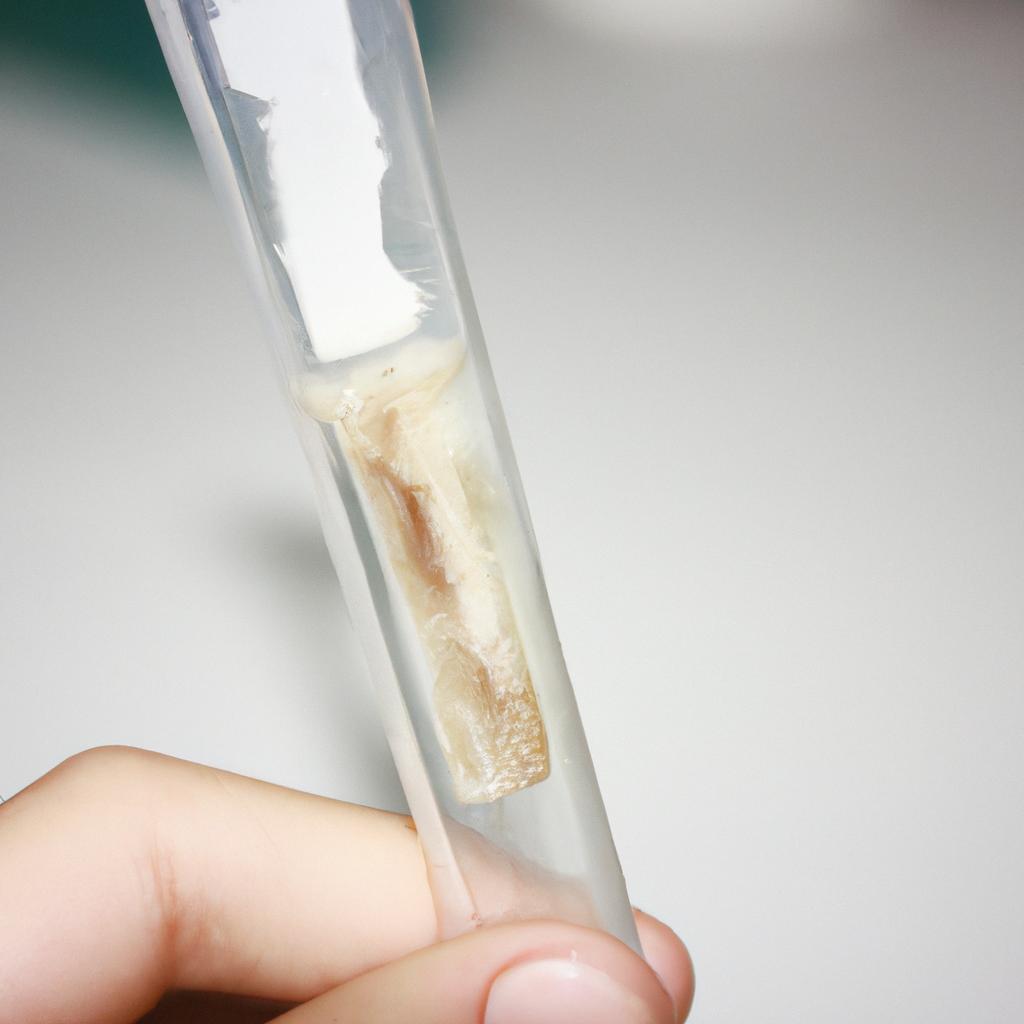White blood cell differential analysis is a crucial component of veterinary clinical pathology, providing valuable insights into the inflammatory and immune response in animals. By examining the proportions of different types of white blood cells present in a sample, veterinarians can gain important diagnostic information about various diseases and infections affecting their patients. For instance, consider a hypothetical case study where a dog presents with recurring episodes of fever and lethargy. Through a thorough white blood cell differential analysis, veterinarians can identify an increased percentage of neutrophils, suggesting an ongoing bacterial infection.
In recent years, advancements in technology have revolutionized the field of veterinary hematology, enabling more accurate and efficient analysis of white blood cells. Automated analyzers have replaced manual counting methods, allowing for increased precision and reduced human error. Additionally, computer-assisted software programs now assist in classifying different types of white blood cells based on their size, shape, granularity, and staining properties. These technological developments have not only improved the speed at which results are obtained but also enhanced the reliability and reproducibility of white blood cell differential analysis.
Understanding the significance and interpretation of white blood cell differentials is vital for veterinary practitioners to make informed decisions regarding diagnosis and treatment plans for their animal patients. This article aims to delve deeper into the principles and practical applications of white blood cell differential analysis in veterinary medicine, providing insight into its role in disease diagnosis and monitoring.
White blood cell differential analysis involves examining the different types of white blood cells present in a sample, including neutrophils, lymphocytes, monocytes, eosinophils, and basophils. Each type of white blood cell plays a unique role in the body’s immune response, and alterations in their proportions can indicate specific diseases or conditions.
Neutrophils are the most abundant white blood cells and are typically the first to respond to infection or inflammation. An increased percentage of neutrophils, known as neutrophilia, often indicates bacterial infections. Conversely, decreased neutrophil counts may be seen with viral infections or certain drug reactions.
Lymphocytes are responsible for adaptive immunity and can be further categorized into B-cells and T-cells. An increase in lymphocyte count, called lymphocytosis, may suggest viral infections or chronic inflammatory diseases. On the other hand, decreased lymphocyte counts can be seen with stress or immunosuppressive conditions.
Monocytes play a role in phagocytosis and antigen presentation. Elevated monocyte counts may indicate chronic inflammation or tissue injury.
Eosinophils are involved in allergic reactions and parasitic infections. Increased eosinophil counts (eosinophilia) can be seen with allergies or certain parasite infestations.
Basophils release substances like histamine during allergic responses. While basophil counts are generally low in animals compared to humans, an increase (basophilia) may occur with allergic reactions or some hematological disorders.
Interpreting a white blood cell differential analysis requires considering the overall clinical context along with other diagnostic tests. It is essential to evaluate trends over time rather than relying solely on one isolated result. Additionally, species-specific differences should be taken into account when interpreting results since normal ranges vary between different animals.
In summary, white blood cell differential analysis is a valuable tool in veterinary medicine for diagnosing and monitoring various diseases and conditions. Technological advancements have improved the accuracy and efficiency of this analysis, enabling veterinarians to make more informed decisions regarding their patients’ health. By understanding the principles and interpretation of white blood cell differentials, veterinary practitioners can enhance their ability to provide optimal care for their animal patients.
Understanding White Blood Cells
Imagine a scenario where a veterinary clinician examines the blood sample of a young dog presenting with unexplained lethargy and loss of appetite. The microscope reveals an abundance of white blood cells (WBCs), indicating an ongoing immune response within the body. This simple case study underscores the importance of understanding white blood cells in veterinary clinical pathology.
Characteristics and Functionality of White Blood Cells:
White blood cells, also known as leukocytes, play a crucial role in defending the body against infections and diseases. These specialized cells are produced in the bone marrow and circulate throughout the bloodstream, ready to respond to any potential threat. There are different types of white blood cells, each with unique characteristics and functions:
- Neutrophils: These are the most abundant type of WBCs and act as first responders during infection or injury.
- Lymphocytes: Responsible for long-term immunity, lymphocytes include T-cells, B-cells, and natural killer cells.
- Monocytes: Transforming into macrophages upon entering tissues, monocytes engulf foreign particles and cellular debris.
- Eosinophils: Primarily involved in allergic reactions and defense against parasitic infections.
Importance of Differential White Blood Cell Count:
Analyzing the differential white blood cell count is essential for diagnosing various medical conditions in animals. By quantifying the different types of WBCs present in a blood sample, veterinarians can gain valuable insights into potential underlying health issues. For instance, an increase in eosinophils may indicate allergies or parasites, while decreased neutrophil counts could be indicative of certain viral infections.
By comprehending the significance behind these variations in white blood cell populations found within animal patients’ samples, veterinary clinicians can make informed decisions regarding appropriate treatment plans. In our subsequent section on “Importance of Differential White Blood Cell Count,” we will delve deeper into the implications and clinical applications of this crucial diagnostic tool.
Importance of Differential White Blood Cell Count
Understanding White Blood Cells is crucial in veterinary clinical pathology as it provides valuable insights into an animal’s immune system and overall health. In this section, we will explore the importance of performing a differential white blood cell count and its significance in diagnosing various diseases and conditions.
To illustrate the relevance of a differential white blood cell count, let us consider a case study involving a dog named Max. Max presented with lethargy, fever, and loss of appetite. A complete blood count (CBC) was performed, including a differential white blood cell count. The results revealed an increased number of neutrophils, indicating bacterial infection. This finding guided the veterinarian towards appropriate treatment options for Max.
Performing a differential white blood cell count allows veterinarians to gain further insight into an animal’s immune response by identifying different types of white blood cells present in their bloodstream. These cells play specific roles in defending against pathogens or responding to inflammatory processes. By analyzing the proportions of each type of white blood cell present, veterinarians can make more accurate diagnoses and tailored treatment plans for animals like Max.
The following bullet point list highlights some key benefits of conducting a differential white blood cell count:
- Enables early detection and diagnosis of infections or inflammatory conditions.
- Helps monitor progress during treatment or recovery phases.
- Identifies potential underlying immunological disorders that may require additional investigation.
- Assists in determining if certain medications are affecting specific components of the immune system differently.
In addition to interpreting numerical data from a CBC with differential, visualizing the information through tables can enhance understanding and evoke emotional responses among readers. Consider the following table showcasing typical ranges for different types of white blood cells:
| Type | Normal Range |
|---|---|
| Neutrophils | 50 – 75% |
| Lymphocytes | 20 – 40% |
| Monocytes | 2 – 8% |
| Eosinophils | 1 – 4% |
By analyzing this table, veterinary professionals can appreciate the importance of maintaining a balance between various white blood cell types. Furthermore, it allows them to identify abnormalities and deviations from normal ranges that may indicate underlying health issues.
Understanding the significance of performing a differential white blood cell count is crucial in veterinary clinical pathology. It provides valuable information about an animal’s immune system and helps guide treatment decisions.
Types of White Blood Cells
White Blood Cell Differential in Veterinary Clinical Pathology: Hematology Insights
Importance of Differential White Blood Cell Count:
In veterinary clinical pathology, the white blood cell (WBC) differential count is a crucial diagnostic tool that aids in the identification and assessment of various diseases. By analyzing the different types of white blood cells present in a sample, veterinarians can gain valuable insights into an animal’s immune system response and overall health.
For instance, let’s consider a hypothetical case study involving a dog presenting with chronic inflammation. Through a WBC differential count, it becomes evident that there is a significant increase in neutrophils, indicating an ongoing bacterial infection or inflammatory process. This finding prompts further investigations to identify the underlying cause and determine appropriate treatment strategies.
Types of White Blood Cells:
To better understand how differential white blood cell counts contribute to veterinary clinical pathology, it is important to familiarize ourselves with the different types of white blood cells commonly encountered:
- Neutrophils: These are the most abundant type of white blood cells involved in acute inflammatory responses. Their main function is phagocytosis – engulfing and destroying invading bacteria.
- Lymphocytes: Known for their role in adaptive immunity, lymphocytes play a vital role in producing antibodies and mounting specific immune responses against pathogens.
- Monocytes: As part of the innate immune system, monocytes differentiate into macrophages when they enter tissues. They act as scavengers by ingesting cellular debris and pathogens.
- Eosinophils: Primarily associated with allergic reactions and parasitic infections, eosinophils release toxins to combat parasites and regulate hypersensitivity reactions.
The following table provides a concise summary of these four major types of white blood cells along with their primary functions:
| White Blood Cell Type | Primary Function |
|---|---|
| Neutrophils | Phagocytosis |
| Lymphocytes | Antibody production, immune response |
| Monocytes | Macrophage differentiation, phagocytosis |
| Eosinophils | Parasite defense, regulation of allergic reactions |
Understanding the roles and functions of different white blood cells through a differential count enables veterinarians to recognize specific patterns in disease processes. This knowledge not only aids in accurate diagnosis but also guides treatment decisions for improved patient outcomes.
Role of Neutrophils in Veterinary Clinical Pathology:
Transitioning from our discussion on the types of white blood cells, we now delve into exploring the crucial role played by neutrophils in veterinary clinical pathology. By examining their presence, quantity, and characteristics, veterinarians can gain valuable insights into an animal’s immune response and identify potential underlying conditions or infections that require attention.
Role of Neutrophils in Veterinary Clinical Pathology
Section H2: Role of Neutrophils in Veterinary Clinical Pathology
Section H3: Importance of Eosinophils and Basophils in Disease Diagnosis
In the previous section, we discussed the significant role played by neutrophils in veterinary clinical pathology. Now, let us delve into the importance of eosinophils and basophils in disease diagnosis.
To illustrate their relevance, consider a hypothetical case study involving an eight-year-old domestic shorthair cat presenting with pruritus (itching) and alopecia (hair loss). Upon conducting a complete blood count (CBC), elevated levels of both eosinophils and basophils were observed. This finding led to further investigation for potential underlying causes such as allergies or parasitic infections.
Understanding the unique contributions of different white blood cell types is crucial for accurate diagnosis and effective treatment planning. Here are some key points regarding eosinophils and basophils:
-
Eosinophils:
- These cells play a vital role in immune responses against parasites.
- Elevated eosinophil counts can indicate allergic reactions or parasitic infestations.
- They release toxic granules that help eliminate parasites from tissues.
-
Basophils:
- Basophilia often suggests hypersensitivity reactions or certain hematological disorders.
- These cells release histamine during inflammatory responses, contributing to itching and swelling.
- Basophil activation can be triggered by allergens, autoimmune conditions, or neoplastic diseases.
To gain a comprehensive understanding of white blood cell differential analysis, it is essential to recognize the significance of eosinophils and basophils alongside other cell types. By carefully examining their relative proportions within a patient’s blood sample, veterinarians can gather valuable insights leading to accurate diagnoses.
Moving forward, we will explore the significance of lymphocytes in disease diagnosis. Understanding their role and behavior is crucial for comprehensive clinical pathology assessments.
[Transition Sentence] Next, let us shift our focus to the significance of lymphocytes in disease diagnosis, shedding light on their crucial contributions to veterinary clinical pathology.End Section H3
Significance of Lymphocytes in Disease Diagnosis
Neutrophils, a type of white blood cell, play a crucial role in veterinary clinical pathology. These cells are an integral part of the immune system and are primarily responsible for defending the body against bacterial infections. By understanding their significance, veterinarians can gain valuable insights into diagnosing and managing various diseases.
One example that highlights the importance of neutrophils is the case of a canine patient presenting with severe skin inflammation. Upon examination, it was found that the dog had a high number of neutrophils in its peripheral blood. This observation led to further investigations which revealed an underlying bacterial infection as the primary cause for the skin inflammation. Prompt treatment targeting these bacteria allowed for successful resolution of the condition.
The role of neutrophils in disease diagnosis goes beyond this particular case study. Here are some key points underscoring their significance:
- Neutrophil count: Monitoring neutrophil levels aids in assessing ongoing or resolving infections.
- Morphological analysis: Evaluating morphological changes within neutrophils provides vital clues about specific diseases or conditions.
- Differential counts: Differentiating between different types of neutrophils (band forms versus segmented forms) helps determine the stage and severity of certain infections.
- Neutropenia evaluation: Assessing reduced numbers of circulating neutrophils assists in identifying potential immunocompromised states.
To provide a comprehensive overview, we have included a table outlining common disorders associated with abnormal neutrophil findings:
| Disorder | Abnormal Neutrophil Finding |
|---|---|
| Bacterial Infections | Increased total neutrophil count |
| Chronic Granulomatous Disease | Impaired function |
| Drug-induced Toxicity | Altered morphology |
| Autoimmune Disorders | Decreased or dysplastic neutrophils |
Understanding the role and significance of neutrophils in veterinary clinical pathology is essential for accurate diagnosis and effective treatment. By examining the patient’s blood, veterinarians can gain valuable insights into potential underlying infections or conditions that may be affecting an animal’s health.
Transitioning to the next section about “Eosinophils and Basophils: Unveiling their Functions,” an examination of other white blood cells will further broaden our understanding of how each type contributes to veterinary clinical pathology.
Eosinophils and Basophils: Unveiling their Functions
Having explored the significance of lymphocytes in disease diagnosis, we now turn our attention to two other types of white blood cells that play crucial roles in veterinary clinical pathology – eosinophils and basophils. Understanding the functions of these cells provides valuable insights into their involvement in various physiological and pathological processes.
Eosinophils are a type of granulocyte characterized by their distinctive staining properties when exposed to acidic dyes. These cells primarily function as mediators of allergic reactions and defense against parasitic infections. For instance, consider a hypothetical case where a dog presents with severe pruritus (itching) and skin lesions. Upon microscopic examination, an elevated number of eosinophils is observed, indicating the possibility of an underlying allergic dermatitis or parasitic infestation. This example underscores the importance of assessing eosinophil levels as part of comprehensive diagnostic investigations.
To further emphasize the role of eosinophils and basophils in veterinary clinical pathology, let us explore some key aspects:
-
Eosinophilia:
- Definition: Increased numbers of circulating eosinophils.
- Causes: Allergic diseases, parasitic infections, certain neoplasms.
- Diagnostic Value: Can help identify specific conditions such as asthma, atopy, or helminthiasis.
-
Basophil Degranulation:
- Function: Release histamine and other vasoactive substances during immune responses.
- Role in Hypersensitivity Reactions: Immediate hypersensitivity reactions involve rapid degranulation of basophils leading to systemic manifestations like urticaria (hives), angioedema (swelling), or even anaphylaxis.
-
Mast Cell Similarities:
- Shared Characteristics: Both basophils and mast cells contain cytoplasmic granules.
- Differentiation: Basophils circulate in the bloodstream, while mast cells reside in tissues.
- Collaborative Efforts: Both cell types play crucial roles in allergic responses and immune modulation.
In conclusion, eosinophils and basophils contribute significantly to veterinary clinical pathology. By understanding their functions and assessing their levels during diagnostic investigations, veterinarians can gain valuable insights into underlying disease processes. Whether it be identifying allergies or detecting parasitic infections, these white blood cells serve as indispensable tools for accurate diagnosis and effective treatment planning.
 Vet Clin Path Journal
Vet Clin Path Journal



